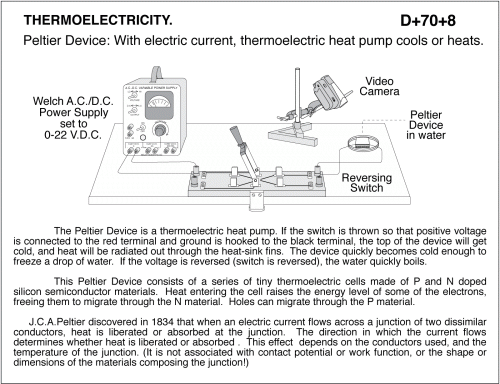Peltier junction: Forward current freezes water drop, reverse boils.
Primary tabs
Peltier Device. The Peltier Device is a thermoelectric heat pump. If the switch is thrown so that positive voltage is connected to the red terminal and ground is hooked to the black terminal, the top of the device will get cold, and heat will be radiated out through the heat-sink fins. The device quickly becomes cold enough to freeze a drop of water. If the voltage is reversed (switch is reversed), the water quickly boils. J.C.A.Peltier discovered in 1834 that when an electric current flows across a junction of two dissimilar conductors, heat is liberated or absorbed at the junction. The direction in which the current flows determines whether heat is liberated or absorbed . This effect depends on the conductors used, and the temperature of the junction. (It is not associated with contact potential or work function, or the shape or dimensions of the materials composing the junction!) Peltier, sending a current through a thermocouple made of antimony and bismuth, froze a drop of water: the first demonstration of thermoelectric refrigeration. This Peltier Device consists of a series of tiny thermoelectric cells made of P and N doped silicon semiconductor materials. Heat entering the cell raises the energy level of some of the electrons, freeing them to migrate through the N material. Holes can migrate through the P material. This module will produce or absorb 2.9 Watts of power when 2.5 amps flow through it at 2.06 volts. It will exhibit a change in temperature of 67 degrees C at that current. NOTE: Not more than 2.1 amps should flow through the device. If a 6 volt battery is used, then an 1.5 Ohm 10 Watt current-limiting resistor should be in the circuit. A Genencon hand-generator (not shown) can also be used
UCB Index:
D+70+8
PIRA Index:
5E50.60
UCB Taxonomy:
PIRA Taxonomy:
Popularity:
- Log in to post comments

